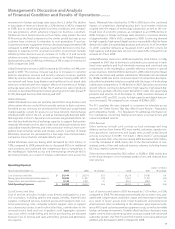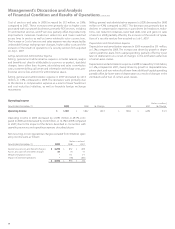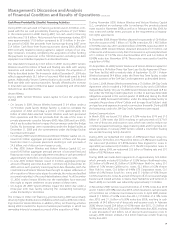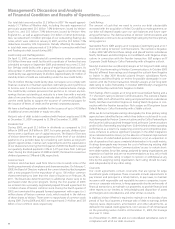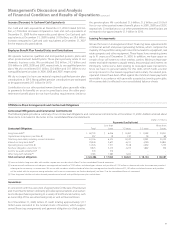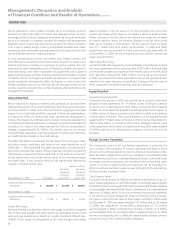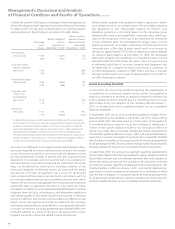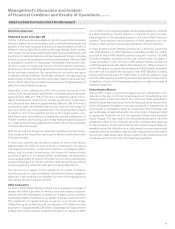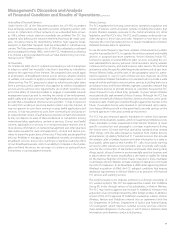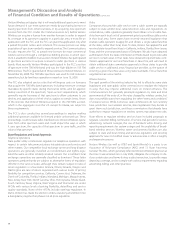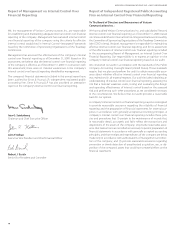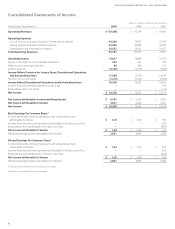Verizon Wireless 2009 Annual Report Download - page 36
Download and view the complete annual report
Please find page 36 of the 2009 Verizon Wireless annual report below. You can navigate through the pages in the report by either clicking on the pages listed below, or by using the keyword search tool below to find specific information within the annual report.
34
• Verizon’s plant, property and equipment balance represents a signifi-
cant component of our consolidated assets. We record plant, property
and equipment at cost. Depreciation expense on Verizon’s local
telephone operations is principally based on the composite group
remaining life method and straight-line composite rates, which pro-
vides for the recognition of the cost of the remaining net investment
in local telephone plant, less anticipated net salvage value, over the
remaining asset lives. An increase or decrease of 50 basis points to the
composite rates of this class of assets would result in an increase or
decrease of approximately $775 million to depreciation expense based
on year-end plant balances at December 31, 2009. We depreciate
other plant, property and equipment on a straight-line basis over the
estimated useful life of the assets. We expect that a one-year increase
in estimated useful lives of our plant, property and equipment that
we depreciate on a straight line basis would result in a decrease to
our 2009 depreciation expense of $968 million and that a one-year
decrease would result in an increase of approximately $1,219 million in
our 2009 depreciation expense.
Recent Accounting Standards
In June 2009, the accounting standard regarding the requirements of
consolidation accounting for variable interest entities was updated to
require an enterprise to perform an analysis to determine whether the
entity’s variable interest or interests give it a controlling interest in a vari-
able interest entity. The adoption of this standard, effective January 1,
2010, is not expected to have a significant impact on our consolidated
financial statements.
In September 2009, the accounting standard regarding multiple deliver-
able arrangements was updated to require the use of the relative selling
price method when allocating revenue in these types of arrangements.
This method allows a vendor to use its best estimate of selling price if
neither vendor specific objective evidence nor third party evidence of
selling price exists when evaluating multiple deliverable arrangements.
This standard update is effective January 1, 2011 and may be adopted pro-
spectively for revenue arrangements entered into or materially modified
after the date of adoption or retrospectively for all revenue arrangements
for all periods presented. We are currently evaluating the impact that this
standard update will have on our consolidated financial statements.
In September 2009, the accounting standard regarding arrangements
that include software elements was updated to require tangible products
that contain software and non-software elements that work together to
deliver the products essential functionality to be evaluated under the
accounting standard regarding multiple deliverable arrangements. This
standard update is effective January 1, 2011 and may be adopted pro-
spectively for revenue arrangements entered into or materially modified
after the date of adoption or retrospectively for all revenue arrangements
for all periods presented. We are currently evaluating the impact that this
standard update will have on our consolidated financial statements.
A sensitivity analysis of the impact of changes in these assumptions on
the benefit obligations and expense (income) recorded as of December
31, 2009 and for the year then ended pertaining to Verizon’s pension
and postretirement benefit plans is provided in the table below.
(dollars in millions)
Percentage
point
change
Benefit obligation*
increase
(decrease) at
December 31, 2009
Expense increase
(decrease) for the
year ended
December 31, 2009
Pension plans
discount rate +0.50 $ (1,291) $(52)
–0.50 1,413 56
Long-term rate of
return on pension
plan assets +1.00 –(346)
–1.00 –346
Postretirement plans
discount rate +0.50 (1,436) (75)
–0.50 1,588 94
Long-term rate
of return on
postretirement
plan assets +1.00 –(37)
–1.00 –37
Health care
trend rates +1.00 3,053 450
–1.00 (2,520) (302)
* In determining its pension and other postretirement obligation, the Company used a
6.25% discount rate. The rate was selected to approximate the composite interest rates
available on a selection of bonds available in the market at December 31, 2009. The
bonds used in developing the composite interest rate were U.S. dollar denominated,
rated Aa3 to Aa1 by Moody’s Investor Services or AA- to AA+ by Standard & Poor’s.
The bonds selected had maturities that coincided with the time periods during which
benefits payments are expected to occur, were non-callable and available in sufficient
quantities to ensure marketability (at least $150 million par outstanding).
• Our current and deferred income taxes, and associated valuation allow-
ances, are impacted by events and transactions arising in the normal
course of business as well as in connection with the adoption of new
accounting standards, changes in tax laws and rates, acquisitions and
dispositions of businesses and non-recurring items. As a global com-
mercial enterprise, our income tax rate and the classification of income
taxes can be affected by many factors, including estimates of the
timing and realization of deferred income tax assets and the timing
and amount of income tax payments. We account for tax benefits
taken or expected to be taken in our tax returns in accordance with the
accounting standard relating to the uncertainty in income taxes, which
requires the use of a two-step approach for recognizing and measuring
tax benefits taken or expected to be taken in a tax return. We review
and adjust our liability for unrecognized tax benefits based on our best
judgment given the facts, circumstances, and information available at
each reporting date. To the extent that the final outcome of these tax
positions is different than the amounts recorded, such differences may
impact income tax expense and actual tax payments. We recognize
any interest and penalties accrued related to unrecognized tax benefits
in income tax expense. Actual tax payments may materially differ from
estimated liabilities as a result of changes in tax laws as well as unan-
ticipated transactions impacting related income tax balances.
Management’s Discussion and Analysis
of Financial Condition and Results of Operations continued



